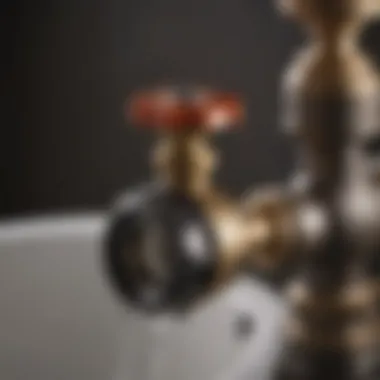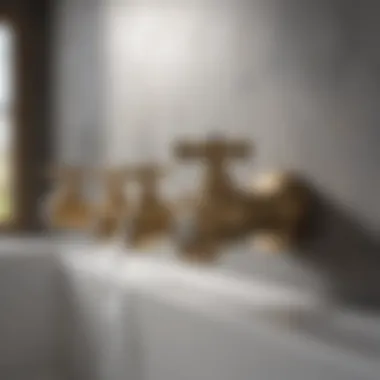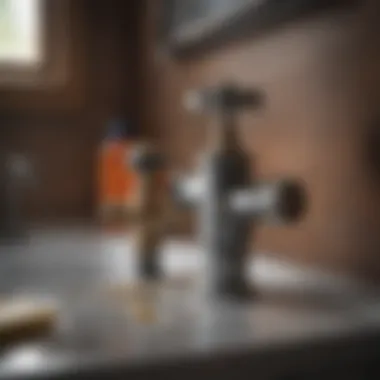Understanding Shut Off Valves for Bathroom Faucets


Intro
Shut off valves play a critical role in the plumbing landscape, particularly when it comes to bathroom faucets. These devices provide control over water flow, allowing for easy maintenance and emergency plumbing measures without affecting the entire system. The importance of understanding these fixtures cannot be overstated, especially for homeowners and renters.
Knowing how shut off valves work—and where they are located—can prevent unwanted water damage and facilitate smoother faucet repairs. This guide seeks to illuminate the essentials of shut off valves, ensuring that both seasoned DIY enthusiasts and those new to plumbing are equipped with the knowledge needed for effective bathroom upkeep.
Design Inspirations
Though shut off valves are primarily functional components, their placement and accessibility can influence overall bathroom design. When planning a bathroom's layout, consideration of these valves becomes necessary to maintain a balance between aesthetics and practicality.
Latest Trends in Bath and Bedroom Design
In modern design, simplicity is key. Many homeowners opt for concealed shut off valves, integrating them seamlessly into cabinetry or behind access panels. This provides a clean look while ensuring that the controls remain functional.
Considerations for design:
- Accessibility: Valves should be within reach for emergency situations.
- Space Utilization: Use cabinets to hide plumbing elements without compromising functionality.
- Style Integration: Match valve covers with fixtures or cabinetry for a unified appearance.
Color Palettes and Themes
While shut off valves themselves typically come in standard finishes, their surroundings can benefit from thoughtful color choices. Neutral tones often work best, allowing fixtures to blend in without drawing attention. Choosing complementary colors can enhance the overall bathroom decor while ensuring that practical elements are not overlooked.
Functional Elements
Understanding the functional elements of shut off valves can lead to more efficient bathroom management. Proper knowledge ensures that repairs can be handled quickly and effectively, reducing the risk of extensive water damage.
Space Optimization Tips
When planning the layout around shut off valves, ensure that they are not obstructed by bulky furniture or fixtures. Adequate space around these valves allows for easier access and operation.
Multi-Functional Furniture Choices
Selecting furniture that incorporates storage for plumbing tools or necessities can also create a cleaner environment. Vanities with built-in compartments assist in maintaining an organized space while ensuring all plumbing tools are within close reach if emergencies arise.
"Proper planning around plumbing fixtures can save homeowners time and money in maintenance."
In understanding shut off valves, the emphasis on both functionality and design allows for a cohesive bathroom space that is both practical and visually appealing. This foundational knowledge sets the stage for further exploration into the types, installation, and maintenance practices that will be discussed in subsequent sections.
Preamble to Shut Off Valves
Shut off valves serve a crucial role in the plumbing systems of bathrooms, particularly when it comes to managing water flow. These valves enable homeowners and renters to control water supply to faucets and fixtures efficiently. By having a fundamental understanding of shut off valves, residents can address minor plumbing issues without calling a professional.
Definition of Shut Off Valves
Shut off valves are types of valves that regulate the flow of water through a pipe. They can be closed to stop water flow, which is essential for maintenance or repairs. Typically, they are located under sinks or behind bathroom fixtures. Their structure usually comprises a handle, which can be turned to open or close the valve, and a body that connects to the plumbing system. The design may vary among different types of shut off valves, such as ball valves, gate valves, and compression valves.
Importance in Plumbing Systems
The significance of shut off valves in plumbing systems cannot be overstated. Having these valves in place allows for a quick response in emergencies, like leaks or overflowing sinks. Without them, controlling water flow becomes difficult during repairs, leading to potential damage or wastage.
"Shut off valves not only prevent leaks but also enable efficient maintenance, contributing to the longevity of plumbing systems."
In addition, shut off valves enhance safety by preventing unwanted water flow. This feature is particularly beneficial when traveling or during prolonged periods of inactivity in a home. Knowing how to operate these valves can save money on repairs and water waste. Individuals should routinely check these valves to ensure they function correctly and are not corroded.
Types of Shut Off Valves


Understanding different types of shut off valves is crucial for maintaining effective plumbing systems in your bathroom. Each type of valve has distinct characteristics that can affect how well they function in controlling water flow. This section offers an overview of the three most common types: Ball valves, Gate valves, and Compression valves. Knowing their specific elements helps in selecting the most suitable valve for their function and setting.
Ball Valves
Ball valves utilize a spherical ball to control water flow. They are designed for quick operation, where a quarter turn of the handle opens or closes the flow. This valve type is notable for its durability and ability to provide a tight seal. Homeowners often prefer ball valves for their reliability and low maintenance. Their simple on-off function ensures ease of use, making them ideal for bathroom faucets where immediate control over water flow is needed.
Ball valves offer superior durability. They last longer and require less effort to operate compared to other valve types.
Additionally, ball valves can withstand high pressure and temperatures, making them suitable for varied plumbing conditions. However, they may not be ideal for applications requiring flow regulation, as they function best when fully opened or closed.
Gate Valves
Gate valves operate using a gate mechanism to start or stop the flow of water. They are designed for minimal pressure loss, making them effective for larger pipe systems. Although they can effectively control flow, they are not ideal for frequent adjustments due to their slower operation. Homeowners might find that this type of valve is useful in main supply lines rather than individual faucets.
The key benefit of gate valves is their ability to deliver non-turbulent flow, which can reduce wear in the plumbing system. However, if not used regularly, gate valves may become stuck, making them less convenient than ball valves for daily operations.
Compression Valves
Compression valves use a threaded mechanism to control water flow. When the handle is turned, a rubber washer creates a seal against water flow. These valves are common in many household applications, particularly in bathroom faucets and sinks. They allow for precise control of water flow, which can be beneficial for tasks that require varying water levels.
While compression valves are easier to install and can be adjusted as needed, they are more susceptible to leaks over time compared to ball or gate valves. Regular maintenance is essential to ensure their proper function. Furthermore, they may require replacement of washers periodically, leading to additional upkeep.
Selecting the Right Shut Off Valve
Choosing the appropriate shut off valve is crucial in maintaining an efficient plumbing system. The right valve ensures a proper fit and function, reducing potential issues that could arise from an improper selection. Understanding the specific needs of your plumbing system can help prevent problems, including leaks and operational difficulties.
When selecting a shut off valve, homeowners and DIY enthusiasts should consider two major elements: size and fit, as well as material variations. Both factors significantly influence the valve's effectiveness and longevity in your bathroom faucet setup.
Considerations for Size and Fit
The size and fit of the shut off valve must correspond to the plumbing system's specifications. A mismatch can lead to major issues during installation or while operating the faucet.
Before purchasing a valve, measure the existing plumbing pipes carefully. Accurate measurements ensure you select a valve that fits properly, minimizing the risk of leaks. The two common sizes of shut off valves are 1/4 inch and 3/8 inch, though other sizes exist depending on specific installations.
Here are some points to keep in mind regarding sizing:
- Pipe Configuration: Understand the layout of your plumbing. This will affect the type of valve you need as well.
- Connection Type: Know whether the connection is compression or soldered, since this influences valve compatibility.
If unsure, consult a plumbing professional to assist you in determining the right size and fit for your specific system. Choosing the correct valve helps to ensure a leak-free and efficient operation.
Material Variations
The materials used in shut off valves are also an important factor in their selection. Various materials offer unique benefits and durability levels. Common materials include:
- Brass: Known for its strength and corrosion resistance, brass is a popular choice for shut off valves. Its durability makes it ideal for long-term use.
- Plastic: Lightweight and resistant to chemical reactions, plastic valves are often used in less demanding applications. However, they may not have the same lifespan as metal options.
- Stainless Steel: For environments prone to rust, stainless steel offers excellent corrosion resistance and longevity.
Each material has its pros and cons. Consider the environment in which the valve will operate and the plumbing conditions as you make your choice. If your plumbing system sees high pressure, for example, opting for a brass or stainless-steel valve might be preferable.
Overall, understanding the considerations for size, fit, and material is essential when selecting the right shut off valve for bathroom faucets. Taking the time to evaluate these factors can significantly enhance your plumbing experience.
Installation Process for Shut Off Valves
The installation of shut off valves is a critical operation in the realm of plumbing. Properly functioning shut off valves are essential for controlling water flow, and a swift installation process is vital to ensure that faucets operate smoothly. This section provides a detailed look at the installation process, focusing on necessary tools, a step-by-step guide, and common mistakes to avoid.
Required Tools


To successfully install a shut off valve, specific tools are needed. Having the right tools ensures the job is done efficiently and effectively. Here is a list of essential tools:
- Pipe Wrench: For gripping and turning the pipes.
- Adjustable Wrench: Useful for various fittings.
- Screwdriver: To tighten screws and fasteners.
- Plumber's Tape: For sealing joints and preventing leaks.
- Teflon Tape: Helps in insulation by creating a watertight seal.
- Bucket: To catch any excess water during installation.
- Safety Goggles: Protection against flying debris.
Having these tools on hand will prepare you for a smooth installation process.
Step-by-Step Installation Guide
Installing shut off valves can seem intimidating, but breaking it down into steps makes it manageable. Here is a simple guide to follow:
- Turn Off the Main Water Supply: Before starting the installation, ensure the water supply to the entire system is turned off. This prevents any unexpected water flow.
- Drain Existing Water: Open faucets and taps to let leftover water drain. This will make the installation process cleaner.
- Remove the Old Valve: Use the pipe wrench to loosen and remove the old shut off valve. You may need to cut the pipe if it’s too corroded or tightly secured.
- Prepare the New Valve: Check that the new valve is compatible with existing pipes. Apply plumber's tape to the threads for a secure fit.
- Install the New Valve: Screw the new valve onto the pipe, tightening it with the adjustable wrench, but be careful not to over-tighten, as this can cause damage.
- Return Water Supply: Slowly turn the main water supply back on and check for any leaks.
- Test Operation: Turn on the valve to ensure it opens and closes properly.
This guide simplifies the process, allowing even those with limited plumbing experience to attempt a valve installation.
Common Mistakes to Avoid
When undertaking the installation of shut off valves, being aware of common mistakes can save time and resources:
- Neglecting to Shut Off Water: Always begin by turning off the water supply to avoid flooding.
- Skipping the Drain Step: Failing to drain existing water can lead to messy situations during the installation.
- Using Incorrect Tools: Not having the appropriate tools can complicate the process.
- Over-tightening Fittings: Applying too much pressure can damage the valve and the pipes.
- Ignoring Pipe Condition: Check pipe integrity. If pipes are old or corroded, it may be necessary to replace them.
These mistakes can lead to prolonged issues down the line. Awareness and preparation are key.
By understanding the installation process, equipped with the right tools and knowledge of common pitfalls, homeowners can effectively manage the installation of shut off valves. This not only enhances the functioning of bathroom faucets but contributes to a more reliable plumbing system.
Maintenance of Shut Off Valves
Maintaining shut off valves is critical to ensuring their longevity and the overall efficiency of your plumbing system. Regular maintenance can help prevent leaks, reduce unexpected water damage, and prolong the life of the fixtures. For housewives and homeowners, this knowledge is important. Understanding how and when to check these valves not only saves potential costs in repairs but also fosters a sense of control over your home's plumbing systems.
Routine Checks and Inspections
Regular routine checks and inspections are essential practices for maintaining shut off valves. These inspections provide an opportunity to identify issues before they escalate.
- Visual Inspection: Start by visually inspecting the valves at least twice a year. Look for signs of moisture, rust, or any build-up of sediment around the valve area.
- Functional Tests: It is advisable to turn the vales off and on. This ensures they operate smoothly without excessive force, which might indicate wear.
- Listen for Unusual Sounds: During operation, listen for any unusual noises. A hissing sound can indicate a leak.
- Check for Water Pressure: Low water pressure might suggest a problem with the valve or upstream blockage.
Performing these checks regularly can preempt larger plumbing issues, thus maintaining the integrity of your plumbing system.
Troubleshooting Common Issues
Despite regular maintenance, issues may still arise with shut off valves. Understanding common problems can aid in effective troubleshooting. Here are some issues to be aware of:
- Leakage and Drips: If you notice water dripping from the valve area, it might be due to worn-out washers or seals. If seals are compromised, simply replacing them can often solve the problem.
- Difficulty in Operation: A valve that is hard to turn or requires excessive force may be corroded or seated improperly. Softening agents or lubrication might help, but persistent issues require deeper inspections.
- Failure to Shut Off: If the valve does not fully close, it might indicate internal damage. In this case, replacement may be necessary.
By addressing these common issues promptly, homeowners can avoid significant repairs, thereby maintaining the functionality of their household plumbing.
Signs of a Failing Shut Off Valve
Recognizing the signs of a failing shut off valve is critical for maintaining a properly functioning plumbing system. Neglecting a malfunctioning valve can lead to more significant plumbing issues, including leaks or even water damage. Homeowners should be vigilant and aware of the symptoms that suggest a valve may need repair or replacement.
Leakage and Drips
One of the most evident indicators of a failing shut off valve is leakage. If you notice water pooling around the valve or dripping consistently, this is cause for immediate attention. Leakage often suggests that the valve's seals are worn out or that corrosion has occurred. It's not just a nuisance; it can also increase your water bill significantly over time.
Regular inspections of your plumbing can help catch these issues early. Look for damp spots on the floor or walls near the valve. If you find moisture, try to determine its source.
Consider the following steps when you notice leakage:
- Identify the source of the drip.
- Assess how extensive the damage might be.
- If the valve is old or heavily corroded, plan to replace it.


Difficulty in Operation
Another sign that a shut off valve may be failing is difficulty in turning the handle or lever. If you find that it’s either too stiff or too loose, this may indicate internal damage. Sometimes, debris can become trapped within the valve mechanism, making it harder to operate. Other times, it may simply be a sign of wear over time.
Should you encounter operational difficulties, it is advisable to avoid forcing the valve to turn. This could worsen the issue or even break the valve. Instead, consider the following actions:
- Inspect for visible debris or buildup.
- Lubricate the handle cautiously, if possible.
- If problems persist, evaluate whether a replacement is more cost-effective than attempting to repair it.
Being mindful of these signs can save you from more extensive repairs. Addressing small issues promptly will help maintain the integrity of your plumbing system. In turn, this ensures that your bathroom faucet functions properly, minimizing the risk of water damage and increasing the longevity of your plumbing setup.
Replacing a Shut Off Valve
Replacing a shut off valve is a crucial task that can significantly affect the performance of your bathroom faucet. Understanding when and how to replace these valves can prevent potential damages and ensure smooth operations. Shut off valves allow you to stop water flow when necessary, making them critical in both routine maintenance and emergency scenarios.
When Replacement is Necessary
There are several indicators that suggest a shut off valve may need replacement. Recognizing these signs early can save you from more extensive plumbing issues down the line.
- Consistent leaking: If you notice water dripping from the valve or pooling around it, this is a clear indication that the valve may have failed.
- Corrosion or rust: A rusty valve is often a sign of deterioration. If the valve body shows visible rust, it should be replaced.
- Difficulty turning the valve: If you find it increasingly hard to operate the valve, its internal components may be damaged.
- Unresponsive valve: In some cases, the valve may not stop the water flow as intended, signaling a malfunction.
In any of these situations, taking prompt action to replace the shut off valve can help you avoid further complications.
Step-by-Step Replacement Process
Replacing a shut off valve involves a methodical approach to ensure safety and efficacy. Here is a step-by-step guide:
- Turn Off the Main Water Supply: Before any work begins, ensure that the main water supply to your home is turned off. This prevents accidental water flow during the replacement.
- Drain the Remaining Water: Open the faucet connected to the valve to allow any remaining water to flow out. This step reduces the risk of mess when you remove the valve.
- Remove the Old Shut Off Valve: Use a wrench to disconnect the valve from the pipes. Be prepared for a small amount of water that may still be in the lines to spill out.
- Prepare the New Valve: Inspect the new shut off valve you have chosen. Ensure it fits the specifications of the old valve and that it is compatible with your plumbing system.
- Install the New Valve: Connect the new shut off valve to the existing pipes. Ensure a tight fit to prevent leaks, but avoid overtightening as it may cause damage.
- Turn On the Main Water Supply: Once the installation is complete, turn the main water supply back on. Check the new valve for any signs of leaks to confirm the installation was successful.
- Test the Valve: Finally, operate the valve to ensure it functions properly. Open and close it a few times to verify that it operates smoothly without any hitches.
By following these steps, you can efficiently replace a shut off valve, maintaining the integrity of your bathroom plumbing system.
"Proper replacement of a shut off valve enhances the safety and functionality of your plumbing system. Always consider consulting with a professional if unsure of the process."
This process ensures you can effectively address any issues associated with failing shut off valves, securing your bathroom against unwanted leaks and ensuring your plumbing works as intended.
Legal and Safety Considerations
Understanding the legal and safety considerations surrounding shut off valves for bathroom faucets is crucial for anyone engaged in plumbing projects. These factors not only ensure compliance with local regulations, they also protect the health and safety of inhabitants.
Local Plumbing Codes
Local plumbing codes are structured guidelines that dictate the installation, repair, and maintenance of plumbing systems within specific regions. These codes often vary from one location to another, which makes it essential for homeowners and contractors to familiarize themselves with their local requirements.
Adhering to local plumbing codes is not just a matter of procedure; it can prevent costly fines and legal issues. Issues arise when installations are done improperly, such as using inappropriate materials or failing to provide proper drainage. The repercussions may include property damage, safety hazards, or even more severe outcomes in case of leaks or water contamination.
For example, some regions might require specific types of shut off valves, while others may mandate installation in particular locations, such as easily accessible areas. It is advisable to contact local authorities or consult resources like en.wikipedia.org for detailed information about your area's regulations.
Safety Precautions During Installation
Safety during the installation of shut off valves cannot be overstated. This process involves handling tools and components that can pose risks if mishandled.
- Turn Off Water Supply: Before starting any work, ensure that the main water supply is turned off. Failing to do so can lead to unexpected surges of water, potentially causing injury or damage.
- Use Protective Gear: Wear safety glasses and gloves to protect against sharp edges and debris. It is important to take these basic safety measures seriously.
- Proper Tools: Ensure that you are using the right tools for the job. Using incorrect or substandard tools can lead to accidents. A pipe wrench, for example, should be appropriate for gripping shut off valves securely.
- Ventilation: Ensure good air circulation in the workspace. This is particularly important if you are using sealants or other chemicals during your installation.
- Seek Help if Needed: If at any point you feel unsure about the installation process, it is wise to consult with a professional or a knowledgeable friend. Overconfidence can lead to mistakes.
"A lack of precaution can lead to unforeseen complications—don't underestimate the importance of safety!"
By adhering to these practices, the risk of accidents can be minimized significantly. Following local plumbing codes and implementing safety precautions is vital for both compliance and well-being in plumbing installations.
End and Summary
Recap of Key Points
In this article, we have highlighted several crucial elements regarding shut off valves:
- Definition and Role: Shut off valves regulate water flow, and their location is vital for immediate access during emergencies.
- Types: Different types such as ball, gate, and compression valves are suited for various needs.
- Installation Process: The installation requires the right tools and knowledge of the step-by-step procedure, allowing homeowners to perform the task safely.
- Maintenance Practices: Regular checks and understanding potential issues ensure longevity and functionality.
- Legal and Safety Aspects: Awareness of local plumbing codes and safety measures during installation protects both the individual and property from potential hazards.
Final Thoughts on Shut Off Valves
Shut off valves are more than just plumbing fixtures; they serve as guardians of your bathroom’s water system. Familiarity with these valves empowers homeowners and solves small problems before they escalate. A proactive approach, including regular inspections and timely replacements, ensures that your bathroom faucets work efficiently. Investing time in understanding these components ultimately leads to better management of household water resources, contributing to responsible usage and peace of mind.















